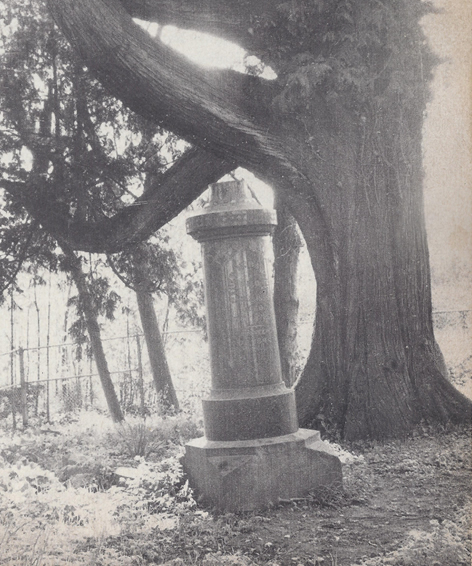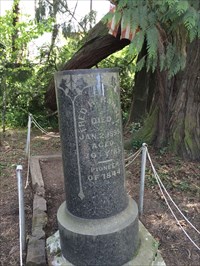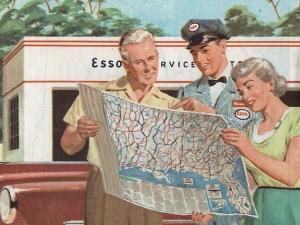The most legendary character of St. Johns was probably Frederick H. Ramsey, better known as Fred Ramsey. He was the only pioneer of St. Johns to receive special recognition in Lambert Florin's series of Historic Graves of the Old West, under the title of "Boot Hill". His life was one of mixed reactions and his death was an ordeal by fire.
His obituary in the Morning Oregonian on January 4, 1895 gave the facts of his death as follows: "On Wednesday night Frederick H. Ramsey, living at the mouth of the Willamette River, opposite Sauvie Island, came to a frightful end, being burned to death in his own home. No one was on hand to render assistance. At 7:30 o'clock last night neighbors of Ramsey living on Sauvie Island discovered the house to be on fire and started to render assistance, but due to the river being full of ice they were unable to cross the stream to mainland. Yesterday morning they went to the house finding the building to be in ruins, and in the charred and smoking ruins lay the body of Ramsey" --, etc. The obituary/news release went on to state that only six weeks before the same thing had happened but the neighbors were able to reach the burning building to save an intoxicated Ramsey, and put out the fire. Ramsey, an alcoholic, had been smoking in bed and fell asleep. It was assumed events had repeated themselves on this fatal occasion.
Where did the story begin? Fred Ramsey was born in Fayette County, Pennsylvania, the same place where John Windle, another local pioneer, was born. The fact that both lived in St. Johns may not have been coincidental. The first record of Ramsey appears in John Minto's Reminiscences. They were both members of Gilliams wagon train of 1844. The first thing Minto said about him was that he had purchased a small bay horse for a Mr. Murray, just west of the American Falls (Idaho), from local indians, because Murray was on foot and the temperature was extremely hot. This clearly indicates that Ramsey was a kind and considerate person but it also indicates that he came west with some financial resources.
Minto said, under date of October 19, 1844 - "We rode in a pouring rain from Oregon City to McCarver's farm on the Tualatin Plains (near Orenco), and found our friends had beaten us by one day. There were five of them who made the trip from The Dalles down the Columbia in one Chinook canoe. There were General McCarver and John Holmes, of 1843 immigration, and Ramsay (Ramsey), Murray and Daniel Clark of 1844. The passage of the cascades delayed them only the difference between floating and walking the three miles of portage. Clark, with the rashness which was a strong trait of his character, shot the canoe down that very dangerous piece of river alone."
"October 20 - The six of us went to work in the timber near the McCarver homestead to get out material and build a rough barn in which to stack the wheat crop yet in the field. By the glancing of an ax from a barked tree to be used for roofing, I (Minto) was cut to the bone of my left leg. Mr. Ramsay (Ramsey) fainted at the sight of the wound. It was bound up, however, with some cotton rags, and he revived in time to help vote me into the office of cook for a working party of eight to ten."
Ramsey liked the Tualatin Plains so much that he filed a claim along Dairy Creek in the general vicinity of West Union and stayed awhile. The 1845 Provisional Government census shows Jimmy John and Fred Ramsey as being both on the west side of the Willamette River, but the record never did show them to be friends even though they were near neighbors. They were two entirely different personalities. In 1848, when the Cayuse Indian War broke out, Ramsey enrolled as a Fifth Sergeant in Company A, 2nd Regiment, Oregon Volunteers. Many pioneers headed for the California gold fields during this war, including the entire populace of Linton, nearly all of Portland, Milwaukie and Oregon City. It is said that Ramsey broke down and went later, leaving a brother in possession of his land claim and three-room cabin (near present day Chimney Park).
Ramsey was best described by Starr Southmayd who remembered him riding about the area at full gallop, and who, after halting his horse, saluted his acquaintance like a calvary soldier... "He often told of trips in a canoe with Capt. (Lt.) Grant and of the times they used to have at Fort Vancouver when the city was the leading social center of the northwest." He claimed to like Indians better than white folks and several of them turned up in this private cemetery. He went about the countryside in buckskins, moccasins and a hat adorned with a pheasant feather. His ultimate land claim included 281.71 acres in Township 2 North, Range 1 West, Sections 23 through 27, all of which appears to be at the confluence of the Willamette and Columbia Rivers. He also owned property in Portsmouth but he chose to live here in the Rivergate area along the waterfront where (uncontaminated) water would be readily available for his whiskey still., He also owned several large and small boats for fishing and bird hunting.
The public record further indicates that, although Ramsey won a land dispute against the heirs of James Loomis to conform to a deed to actual possessory holding, he lost a similar suit by adverse possession to S.I. Ogden for a tract of land which he owned but failed to survey. Ogden mistakenly acquired what he thought was title from P.T. Smith. Smith had acquired this same tract from another person under the same circumstances. Ramsey stood by and watched the property being improved, thought it belonged to Ogden, but wanted it back when he found out it really belonged to him. The Circuit Court and Supreme Court both denied his request.
The Provisional Government records indicate he was a signer of a petition for the pardon of William Melvin, n.d. (No 6803), signer of petition for turnpike charter, 1858 (No 7963) signer of petition for relief of Justin Millard, Jan. 7, 1856 (No. 10903), and Census, Twality county, 1845 (No. 12193). Compassionate in nature, it appears to have remained the same for life except for the "falling out" he had with Ogden.
Fred Ramsey's Last Will and Testament, dated February 1, 1892, left $2000.00 each to Conrad Rinlaub and Irijah Byars. Rinlaub was a 30-year-old man who lived somewhere in the vicinity of the Memorial Coliseum. During Ramsey's later years, he spent most of his weekends and most of his summers on the Ramsey acreage and very often cared for the old man when he was "in his cups". Ramsey also left a $2,000.00 cash bequest to the Sisters of Charity of Providence for the St. Vincent's Hospital. Albert W. Lambert, Treasurer of Multnomah County, was also named as a beneficiary and Executor of the Will. He was to receive a tract of land valued at $5,000.00 for his services as Executor. Lambert was closely associated with Byars. The Ramsey relatives were numerous and litigation ultimately ensued over construction of the residual clause of his Will. The beautiful monument at the intersection of Burgard and Simmons Road (now Lombard St. and Columbia Blvd.) was furnished by Schanen and Neu at a cost of $375.00. J.P. Finley and C.R. Rieger furnished a casket for $55.00 and a outside box for $4.00. Nothing else was needed for he had been so badly burned he no longer had arms nor legs. His pet dog lay beside him.
Ramsey was no only the most colorful citizen of St. Johns but he was also the wealthiest. His estate was composed of at least three city lots in Vancouver. He also owned property in Chehalis and Portsmouth, together with vast tracts of acreage in Clark County, Washington and Multnomah County, Oregon. His Oregon holdings included 658.44 acres and his local estate appraised for $70,000.00 but the property in the State of Washington was equally valuable. William Caples admittedly borrowed $40.00 on a unsecured note and the amount was still due. The box in which the pioneer kept $15,000.00 in notes held against "different parties" in St. Johns was found but fire had destroyed all of the contents and thereby removed the obligation to make payment.
The Ramsey property was farmed separately as "upper" and "lower" tracts by different individuals until finally, about 1929, the entire combined track was taken over by the Widmer Brothers (see the William Gatton biography). Max and Otto Widmer built on three more rooms to the three-room cabin belonging to Ramsey (not the house destroyed by fire). The cattle and hay bars were built and the entire place became a thriving dairy ranch. Some of the Ramsey-Widmer buildings are visible at the top of this photograph taken in 1940. The Widmers remained until the beginning of World War II and they then moved elsewhere. The beautiful productive farm became Meadowlark (full of shacks and small houses without water, wrecking yards, garbage dump facilities, etc.). The Ramsey farm, like Gatton Ranch, was no more from that day forward. The pioneer era had come to an end... a permanent finale from which it shall never revive.
Fred Ramsey once had three brothers, but only his brother John survived him according to his probate records. An article appeared in the St. Johns Review on April 16, 1981, as a reprint, wherein Alvin Baxter is quoted as saying that he had been hired to bury one of Fred's brothers in a plot adjoining Fred's grave. "When finished the brothers were laid head to head on a line east and west. For many years a large tombstone has marked the grave of this early settler, although there is no mention of the brother who was buried there in 1901". Baxter reported that in digging the grave he got nearly a gunnysack full of indian bones as well as four skulls. "Also dug up and thrown to one side were a quantity of pestles and mortars," etc. "All of these items were found in a shallow grave not over two feet deep. The skulls and bones were buried with the brother of Fred Ramsey".
I have always like to refer to the Ramsey burial site as a "one man cemetery" but as you can see there are really two burial plots and so my choice name must be abandoned and applied to some other worthy location.
"Originally the tombstone had a large marble ball on top of it but during the Vanport College era it fell off. The ball remained on the ground for a number of years, then someone rolled it away." - Oregon Journal, June 5, 1953
♦ ♦ ♦
R a m s e y C e m e t e r y
♦ ♦ ♦
Other St. Johns Cemeteries
♦ ♦ ♦
Fred Ramsey
A Lone Pioneer
Ad From 1942 Oregonian.
The park was next to Terminal Road
at the foot of Burgard (now Lombard)
Swift Blvd became Columbia Blvd





